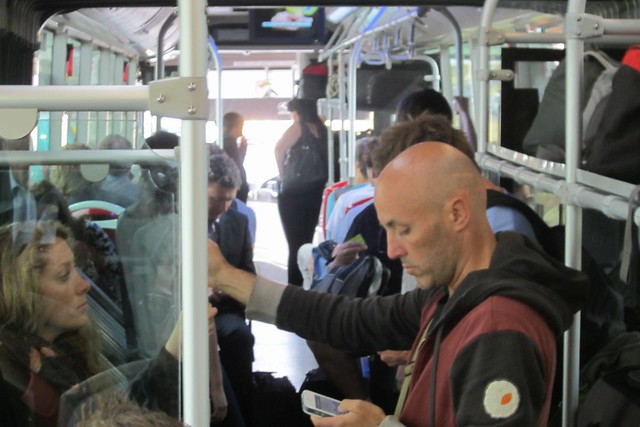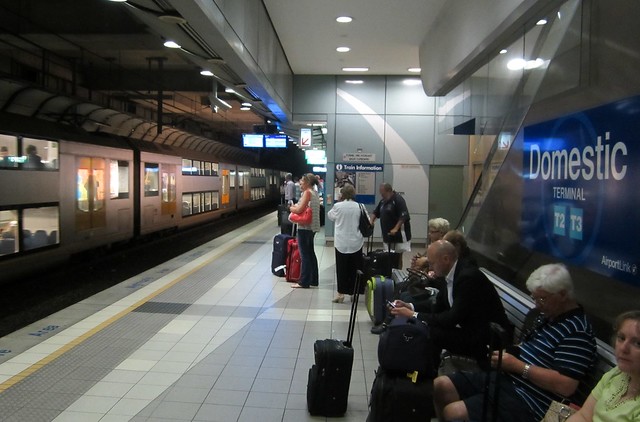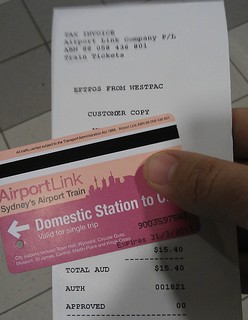The Federal government’s High Speed Rail study assumes a route from Melbourne via Canberra to Sydney of between 823 and 842 km (mostly following existing highways), with trains reaching up to 350 km/h, and a three hour trip time from Melbourne to Sydney.
Some people who argue against the idea like to claim there is no way this estimated three hour travel time could be competitive with air, when the plane trip is only a bit over an hour.
But if the train was Melbourne CBD to Sydney CBD, how does plane compare to that?
On Thursday, I had a quick trip up to Sydney. Here’s how the trip up panned-out (times as close as I can estimate from photos, receipts etc).
9:04am. Step off suburban train from home at Southern Cross. Briskly walk towards the Skybus terminus.
9:10am. Skybus departs towards airport. (There were five more people aboard than seats available.)
9:31am. Skybus makes first stop for international and domestic flights other than Qantas/Jetstar. I stay aboard, though given the traffic in the airport, and the fact that the second bus stop is actually a little way past the Qantas terminal entrances, I always wonder if I should jump off here and walk the rest of the way to Qantas.
9:34am. Alight Skybus at the Qantas stop.
9:38am. Attempt to check-in. This doesn’t work and the machine tells me I need to seek assistance from staff. I don’t know what went wrong, but the staffer got it figured-out. It might have been because my boarding pass for the trip back was linked to a colleague’s who’d flown up earlier in the day.
9:45am. Go through airport security.
9:55am. Board plane.
Just after 10:00, after the last stragglers board and squeeze their barely-fitting carry-on suitcases into the overhead lockers, the plane pushes back.
11:20am. Plane lands. Apparently it’s a distance of 713 km (more or less, obviously since the exact flight path would vary), so if it’s a 75 minute flight, that would be a speed of about 570 km/h.
We (eventually, after aforementioned people struggle to get their suitcases sorted out) alight.
11:33am. Find and enter the Domestic Airport station entrance.
11:37am. Buy rail ticket from the vending machine. By the way, it came with a compulsory receipt (which I needed to claim back from work), which unlike Myki receipts, did not include my name nor the bulk of my credit card number.
11:38am. Go through station gate and down to the platform.
11:43am. Board train to city.
11:54am. Train arrives at Central station. (I stayed on for another 4 minutes, or two stops, to St James, which dropped me in the heart of the CBD.)
By air: 164 minutes. By rail: 180 minutes?
So in fact, the Melbourne CBD to Sydney CBD trip took from 9:10am to 11:54am, or 164 minutes, and that was without having to buy a Skybus ticket (I always buy them online to avoid the queues), without checking in baggage, without long queues at security (there were about 3 people ahead of me in the line), nor any significant delays on the flight, and with a short wait for the train (but I didn’t just miss one, for instance due to buying the train ticket).
I’m not a regular business traveller, but to my untrained eye, this trip appears to be close to the ideal Melbourne to Sydney plane ride. But CBD to CBD, it was only 16 minutes shorter than the theoretical fast train travel time of 3 hours — though one would need to take into account check-in and waiting time for train, of course.
On the train it is likely you’d be able to make phone calls, use the internet and any portable electronic devices one might have handy — with no “turn everything off” blackout period during departure and arrival, as on a plane. You’d also be able to move around more freely.
Certainly it would produce less carbon emissions. And the government’s study is predicated on a train also serving Canberra along the way, making trips to/from there more convenient.
There are significant hurdles to getting High Speed Rail built, of course, particularly the huge infrastructure cost. But in a busy air corridor like Melbourne to Sydney, it’s not hard to imagine that it might work quite well.
I suspect that once they proclaim me emperor, I’ll tell the airlines that starting in, say, 10 years, their flight paths between Melbourne, Canberra and Sydney will be cut by 10% per year. And I’ll recommend they start investing in and building a high-speed rail line to replace their planes, on condition that it’s a joint venture to maximise train frequencies (rather than split them between companies).*
And before you say it’s impossible, Lufthansa Airways is in the train business. (So is Virgin, of course, but Virgin’s into just about every business one can think of.)
- *Footnote: sadly all of this paragraph is unlikely to ever happen.
- The high speed rail study did say that they looked at a Sydney terminus at Parramatta or Homebush, which would cut costs, but obviously lengthen the travel time to the Sydney CBD.




18 replies on “Could High Speed Rail from Melbourne to Sydney be as fast as air travel?”
I’ve done a fair bit of business travel in Europe. Within Germany I think only once I’ve gone with the a flight over the train and that was because I needed to get to an airport.
I have been to Sydney over 25 times in the last 18 months. I would happily take the train. My experience is similar to yours outlined above, which allows for about 30 minutes of “laptop time” from Melbourne to Sydney. On the train I would be working for the full 3 hours. I wouldn’t miss the security theatre at the airport either.
Great case study Daniel. It would be great to have a fast train to Sydney, but, as you suggest, who would pay for it?
Your argument can only be helped by airport security – you went through pretty quickly. Some days it can be ~15 minutes. And the Sydney fog – ~0830 arrival flights for me this year always seemed to have me flying around in loops waiting for the fog. The airline companies should be on board (ha) with fast rail, it’s just another investment.
Good article, Daniel. I don’t travel all that much, but a three (or even four) hour train to Sydney with just one boarding point and one exit (compared to to three of each) sounds great to me. Even if I don’t want ‘laptop time’, its great to just relax and read a book. I have traveled Melbourne to Warrnambool a few times and that is about 3 hrs and I just use the time to relax and ‘chill out’.
I suspect the Sydney-Canberra leg could be very popular as it would only an hour or less most likely.
You also turned up at the airport far too late to be within the usual check-in rules. The ticket tells you to get there at least 30 minutes before your scheduled departure time, so that would add at least 12 minutes to the trip. Even more if you prefer to have a (highly advisable) safety margin in case there’s a queue.
But I’m sure the feasibility study will use that Parramatta or Homebush terminal just to ensure that the train trip is as impractical and unpopular as possible…
You’re right, and even more so for many people. You were happy showing up at the last minute at the airport, but a lot of people like myself will show up much earlier just to stress less about missing the flight through slow traffic/security. For a 10am flight to SYD I’ll often be at Tulla about 8.30am, intending to have breakfast before the flight. So for me the Southern X –> Central journey by air is more like 4 hours +. Personally I’d even take a 5 hour train over that, to avoid both the faffing about getting to/from airports & the silly security theatre (though I guess there’d be some of that with a high speed train too).
So will these clean trains be running on large quantities of coal power or diesel? It seems likely to be a whole heap of tax payer money for what seems to be next to no time benefit. Really I think the money would be much more productive if spent on urban transport in our major metropolitan centres. You could buy a whole lot in useful train, tram, bus, and even road improvements.
I think the fact we even still talk about this populist white elephant is a shame as it distracts and detracts from the more pressing transport problems and solutions we need. Hopefully the coming report knocks this on the head once and for all.
Yes, HSR would be fast enough on the Sydney-Melbourne run to match air.
Still doesn’t make it a sensible idea.
I love fast rail – but I think a Sydney to Brisbane link is probably more sensible with the population in that corridor.
The only way a Sydney to Melbourne would get built first is if it went via Canberra and that would add an extra 30 minutes to the trip.
You’re assuming that they would not introduce “VFT” security, then? Consider the alleged reasons for airport security, and a number of them apply to VFT. soft-target infrastructure, etc.
Austin, not building HSR has not and will not magically result in improved local public transport.
They are 2 different products, the fact that we have crap PT doesnt mean we should have crap inter-state trains too!
Building HSR between Newcastle > SYD > ACT will iliminate the need for building another motorway between those cities, save time, reduce road accidents, reduce oil imports, create jobs, etc.
So Jacob we should spend tens of billions on a VFT to transport a very limited amount of Australians population between what are effectively large regional centres and Sydney? I agree perhaps the NSW/ACT government should look at improving their regional train links like Vic has but perhaps not the full VFT standards and cost. I also think that all transport items are related because at the end of the day there is a limited amount of funds for transport projects (this is why we often have road v.s. rail debates?).
Does the traffic on the motorway outside Sydney’s limits often get so bad as to justify another motorway? Would a new motorway or improvements to the existing cost anywhere near as much as VFT? Would the traffic likely switch to the VFT in enough numbers to negate the need for a new motorway?
At the end of the day the project needs to justify itself as a stand alone project in the here and now against all other projects. Justifying it by saying it will remove the need for a future unfunded and uncommitted project is a bit of a never ending story. i.e. A new Sydney airport with no night limits will eventually be needed would mean the motorways and rail lines to the current airport may not be needed so we should never have built/upgraded them?
People who think high-speed trains have less annoying security and time-wasting than airlines, are probably deluding themselves.
Catching a high-speed train in China requires producing passport or identify card and ticket three times, xray baggage check, and queuing a total of seven times. Its more hassle than the airport. I know this, because I have done it three times this week.
Travelling to a high-speed rail terminal station might, or might not, be more convenient and quicker than travelling to an airport, depending on all of the personal circumstances of the traveller including the duration of the trip and access to public transport and/or their own car.
For people in the suburbs who don’t have good access to public transport, and are only travelling for a few days, it certainly isn’t a “no brainer” to blythly assume that a central train station is as accessible as an airport car park.
So if the train takes only 3 hours ( which I rather doubt is achievable ), I don’t think it will beat the 70 minutes flight time of an aircraft.
So geoff, how does it make more sense with more population in the corridor ? Do you want to annoy more people with the sound of passing trains ? Or add a couple of hours to the trip for all the stopping and starting ?
As much as I’d love to see a Melbourne to Sydney fast rail link, I think it’s unlikely mainly on cost grounds, particularly given how debt adverse Australian politics is. The only part that I think might have any chance would be a Newcastle-Sydney-Canberra section. Of course, that could be extended in the future, but that future will be some time off, I dare suggest.
Re: enno@5:35pm: China (a model I’m well familiar with given that I live here) is not the only way to manage railway security. It should be noted that such security measures apply to all national rail passengers no matter how fast the train. Whilst the security is largely theatre (the speed at which the x-ray scans are conducted doesn’t inspire confidence), it is probably fair to say that the Chinese rail network is very good for personal safety, as one would expect from a railway with its own police force (on board every train) and court system.
Related to this and mike@12:59’s comment, there’s no reason why Australia couldn’t follow other examples such as Germany, where the system when I used it in 2010 from Berlin to Brussels was to turn up at the platform, walk on the train and get your ticket checked on board. A lot like V-Line today, for instance.
I must say I’m with Austin on this one.
It seems to the be the classic ‘infrastructure is the answer’ solution to so many public transport questions.
Maybe a better value project is straightening out the rather torturous rail lines out of the Sydney basin in all directions to benefit both freight and people which would reduce the traffic on the roads (thanks to faster than driving travel times) when combined with more frequency.
I’m not persuaded HSR is immune to security problems e.g:
http://www.csmonitor.com/World/terrorism-security/2011/0506/Bin-Laden-considered-9-11-anniversary-attack-on-US-rail-system
http://rapsinews.com/judicial_news/20121210/265716379.html
http://works.bepress.com/cgi/viewcontent.cgi?article=1012&context=dylankissane
The Melbourne Airport Station Will Be An Underground Station Also Is Gladstone Park,Airport Westm East Kelior,Maribyrnong,Flemington Racecourse,Showgrounds